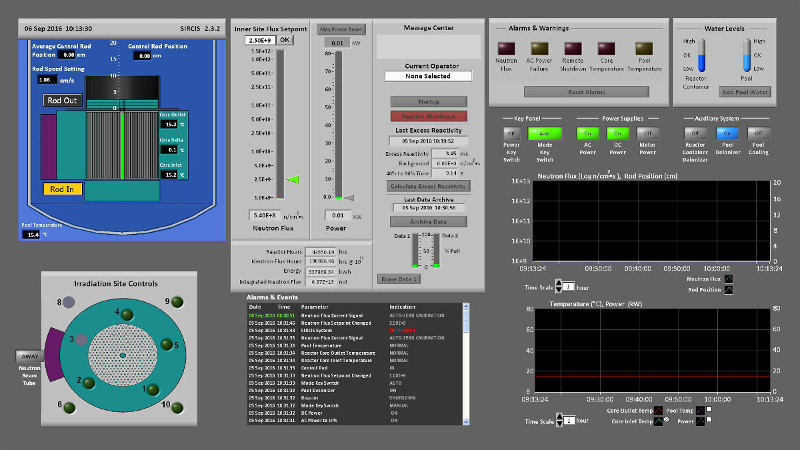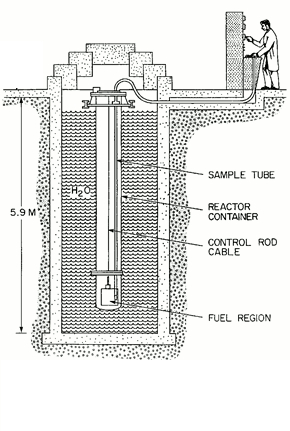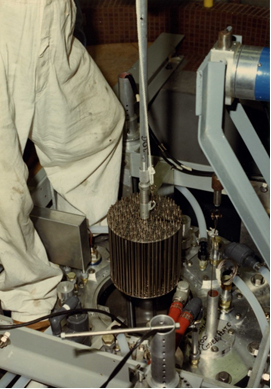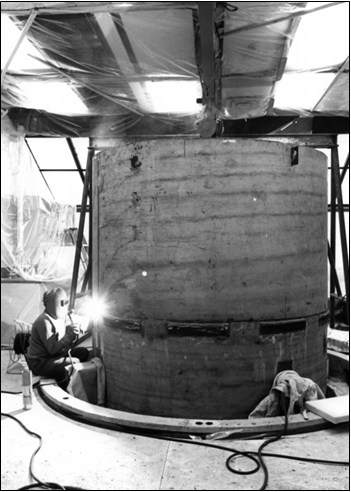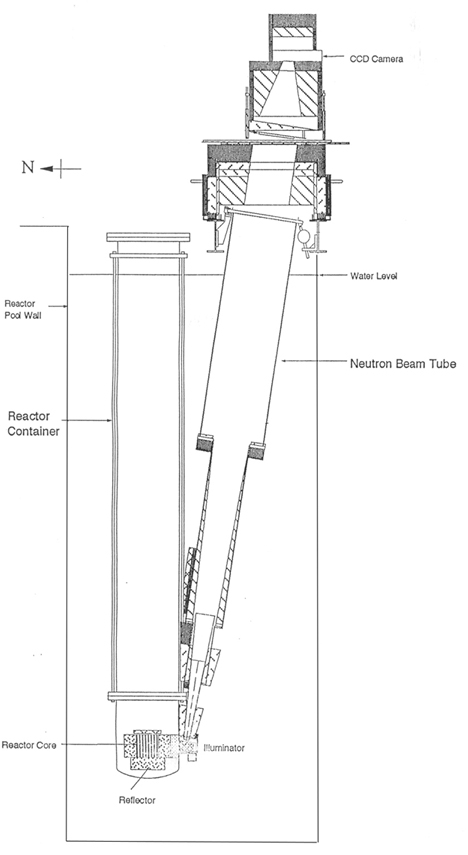Canada & SLOWPOKE
In the 1960’s, nuclear technology was an active, but developing field in Canada. The civilian application of neutron science was a particularly exciting area. Universities often employed radioactive sources or small accelerators to generate neutrons, but as the field grew and larger sources were required, these eventually could not keep up with demand. Atomic Energy Canada Limited offered a uniquely Canadian solution: the Safe LOW POwer (K)Critical Experiment, or SLOWPOKE.
The SLOWPOKE actually has its roots in a paper out of Los Alamos National Laboratory. The paper discussed a critical 235U assembly that, by using beryllium reflectors, required only 300 grams of uranium, and was one of the inspirations for Dr. John Hilborn in developing the SLOWPOKE design. Led by Dr. Hilborn, the SLOWPOKE reactor development took place at Chalk River Nuclear Laboratories in the late 1960’s, and finally came to fruition as the SLOWPOKE-1. The University of Toronto went on to buy this reactor in 1971.
SLOWPOKE-2 design followed shortly thereafter as a larger, improved version of the SLOWPOKE-1. The upgraded design had the highest ratio of neutron production to fission power of any research reactor at the time, and with a nominal power level of 20 kW, could produce a thermal neutron flux of 1012 neutrons cm-2 s-1.
The SLOWPOKE-2 was small enough and inexpensive enough to make it accessible for universities and research centres. The efficient design allowed experiments to be performed at a fraction of the cost of competing models. Ultimately, a SLOWPOKE-2 reactor would be acquired by eight different institutions, seven in Canada and one in Jamaica.
SLOWPOKE Design
The first commercial prototype was the 2 kW SLOWPOKE-1. However, the more successful reactor is the SLOWPOKE-2, with a nominal power of 20 kW. It offered advantages over the SLOWPOKE-1 design in several areas including an increased nominal power level, an increased neutron fluence, and the ability to accommodate up to 10 samples at a time.
A typical SLOWPOKE-2 reactor is a light water moderated, pool-type reactor. It is capable of achieving a flux 1012 neutrons∙cm-2∙s-1 at the five inner irradiation sites and 5x1011 neutrons∙cm-2∙s-1 at the five outer irradiation sites. As is illustrated in the adjacent schematic, SLOWPOKE-2 contains a fuel cage located 4.4 metres under the water. The cage is composed of a zirconium alloy and contains 198 fuel elements. Each element is formed from Zircaloy-4 tubing and is packed with pellets of sintered uranium dioxide (UO2). The core itself is contained within a beryllium annulus that acts as a neutron reflector. The annulus houses the five inner irradiation sites. Additional beryllium reflectors are located below and above the core, with the five outer irradiation sites located outside the beryllium annulus.
The critical mass of uranium in the SLOWPOKE-2 design is approximately 1.1 kg of low-enriched uranium (LEU) or 0.88 kg of high-enriched uranium (HEU). Originally designed to operate with HEU (93%at enrichment), AECL redesigned the SLOWPOKE-2 to use 19.9%at235U LEU, as described in the previous paragraph.
The SLOWPOKE-2, with its inherent safety and scalability to larger systems, speaks volumes to Dr. Hilborn’s skills as an inventor.
Later on, a SLOWPOKE Demonstration Reactor was built at the Whiteshell Laboratories of Atomic Energy of Canada Limited. This model was intended to provide district heating and energy, and was rated at a power level of 2 MW to 10 MW. The reactor was hoped to provide an alternative to oil and diesel for use in remote locations. Another scaled-up version of SLOWPOKE-2, named the SLOWPOKE Energy System (SES), was investigated in order to allow for the production of medical radioisotopes. Unfortunately this design never fully materialized.
The failure of the SES was in part due to public opposition. A clear example of this was the objection by the local population of Sherbrooke, Quebec. AECL wanted to build to an SES reactor at the Centre Hospitalier Universitaire de Sherbrooke. Objections came despite the benefits it offered the hospital, as is evident from comments made by Jean-Roch Perron, hospital chairman in the mid to late 1980’s. Mr. Perron stated that to replace the SES, an AECL investment of $7.5 million, with a cyclotron would cost $10 to 15 million. Furthermore, the hospital would have saved close to $200,000 to $250,000 a year on heating had the SES been implemented. Despite efforts by AECL to dissuade fears and misconceptions of the reactor public opposition proved too much to overcome in the end. Dr. Tamm’s letter to The Record in October 1988 refuted claims made by an earlier article about the SES. These two paper clippings offer only a glimpse (French only) of the climate surrounding the SES.
When the SES was abandoned, the political climate surrounding the nuclear industry was wrong for scale-up and expansion of the SLOWPOKE reactors. Recently, however, with the global shortage of radioisotopes, and an increased concern over climate change and the depleting reserves of fossil fuels, mini-reactor designs similar to the SLOWPOKE Energy system are attracting more and more attention.
SLOWPOKE-2 was purchased by the following institutions:
- University of Toronto
- École Polytechnique de Montréal
- Dalhousie University
- University of Alberta
- Saskatchewan Research Council
- University of West Indies
- MDS Nordion
- Royal Military College of Canada
RMC SLOWPOKE-2 Facility History
The RMC was the last of eight institutions to receive a SLOWPOKE-2 research reactor and the first to be operated with LEU. Dr. R. F. Mann and Dr. L. G. I. Bennett, professors in the Department of Chemistry and Chemical Engineering, oversaw its acquisition and installation.
Pre-planning for the SLOWPOKE-2 Facility began in 1976 when the Sawyer Science and Engineering Building was undergoing construction. A concrete pit 6 metres deep and 2.5 metres in diameter was constructed into the floor of the new building; within six years a stainless steel liner was added to ensure a complete waterproof seal. In August 1985, the LEU reactor fuel and beryllium reflectors were received at a cost of $200,000. The reactor went critical in September of 1985.
In the early 1990’s, a neutron beam tube was added, allowing the capability of neutron radiography with film. This addition is unique to RMC and took advantage of the offset of the SLOWPOKE-2 core from centre alignment (which was planned for the refuelling operation of the reactor). Moreover, the beam tube forced the addition of extra shielding to compensate for the release of neutrons.
In the late 1990’s, a CCD camera was installed in the uppermost beam stop of the beam tube allowing RMC to change from film imaging to digital imaging. The second floor of the Facility contains the radioisotope laboratories and is where most of the day to day sample analysis occurs.
The original SLOWPOKE-2 analog control system was replaced in 2001 by a digital system designed and implemented by Lt(N) L.R. Cosby as part of his master’s degree.
The SLOWPOKE-2 nuclear reactor is the only type of nuclear reactor licensed in Canada for unattended operation in automatic mode. The SLOWPOKE Integrated Reactor Control and Instrumentation System (SIRCIS) was implemented using LabVIEW® professional development software. SIRCIS increased the functionality of the original analog system and improved the overall user interaction.
